Affiliate disclosure: This post may contain affiliate links. Please see our Privacy Policy.
Prickly pear jelly is a real treat, and lets you have a taste of the dessert anywhere in the world.
The fruit has a distinctive taste that’s hard to describe, warm and earthy but also a bit tropical.

I grew up picking prickly pears in my grandfather’s backyard for fun. We’d play with them, but I never knew you could eat them.
I don’t come from a family of cooks, let alone jelly makers. The first time I made prickly pear jelly I was already living clear across the country in the northeast, far from the land of cactus.
Even up here in Vermont, grocery stores will often carry prickly pears as a novelty, next to the dragon fruit and kiwano melons. They keep surprisingly well, and I’ll admit I forgot about these prickly pears on the counter for 2 weeks before I started a batch of prickly pear jelly, but they were still good as the day they were picked inside.
Start by peeling the prickly pears. The skin is a distinct layer on the outside and it comes away easily. Cut off the top and bottom, and then slice through the exterior peel lengthwise.
From there, gently peel away the outside peel. Here’s a pictorial tutorial on peeling prickly pear if you need it. Once they’re peeled, slice them into smaller pieces before placing them in a saucepan with water to cover.
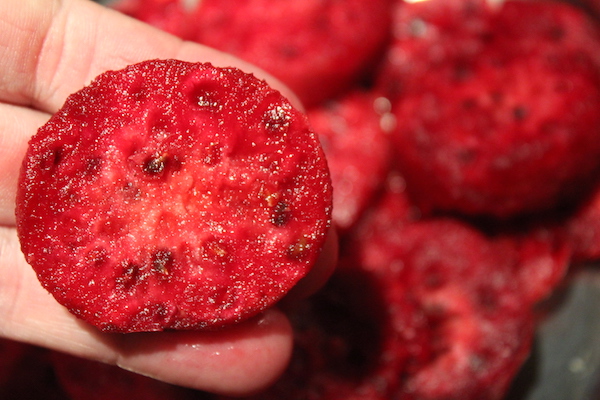
Simmer the prickly pear fruits in water for about an hour, adding water as needed to cover. Occasionally stir and use a spoon to try to break up the fruits and increase the surface area. That helps extract the juice.
After an hour, pour the prickly pear pulp and juice through a fine-mesh strainer. You should have around 1/2 cup of juice for each fruit. It’s important to note that the pH of prickly pear juice is way too high for canning, and you’ll need to add quite a bit of lemon juice to bring it into a safe range for canning.
If you’re not canning the prickly pear jelly, don’t worry about it. Add a few tablespoons for flavor since acid will help bring out the flavor of the fruit, but there’s no need to drastically increase the acidity for a fridge preserve.
Add 1/2 cup of lemon juice or 2 teaspoons citric acid for every cup of prickly pear juice. This is important, and prickly pear jelly is not safe for canning without either lemon juice or citric acid added.

Measure the juice and add 1 cup of sugar for each cup of juice. I’ve seen some recipes calling for as much as 3 cups of sugar per cup of juice, and I find that toxically sweet.
A single cup is already very sweet, bordering on cloying and I can’t see adding more. If you have a serious sweet tooth, maybe consider adding more, but be sure to taste it first.
Pour the juice and most of the sugar back into a saucepan and bring it to a boil on the stove once again. Save about 1/4 to 1/2 of a cup of sugar to the side to mix with the pectin (if you’re using powdered pectin).
Simmer the juice and sugar for about 5 minutes before adding pectin. Prickly pears don’t contain their own pectin, and if you want a jelly it has to be added. Otherwise, you just have prickly pear syrup, which is tasty in its own right.
I’m using Pomona’s Universal Pectin to thicken this batch of prickly pear jelly, and it’s added in powdered form which lets you easily scale up and down based on batch size. It’s also not dependent on sugar to gel, which makes it great for low sugar jams.
This isn’t a low sugar recipe by any stretch of the imagination, but if you do want to make a low sugar prickly pear jelly using 1/2 or even 1/4 cup of sugar to a cup of juice it’ll work with this pectin.
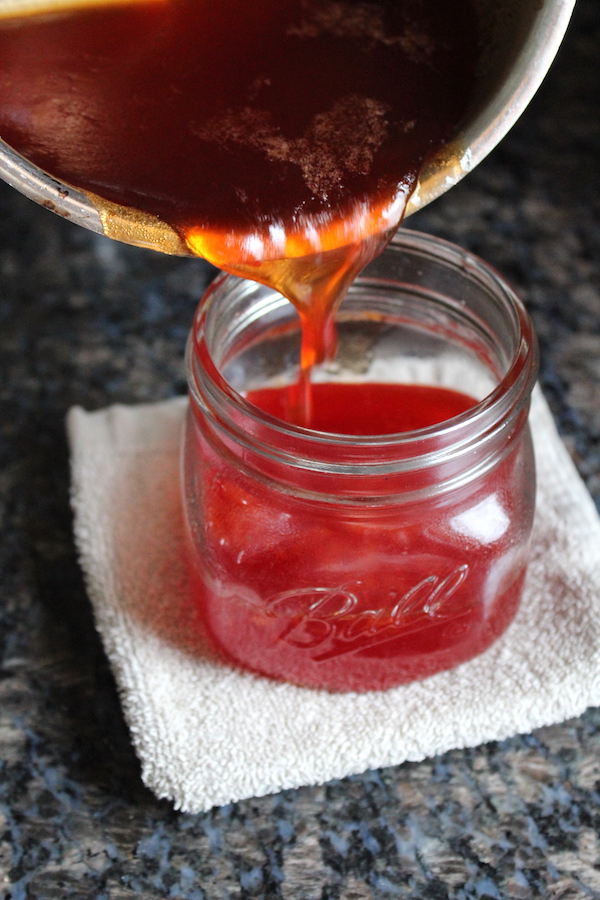
For Pomona’s pectin, I add 1/2 tsp powdered pectin and 1/2 tsp calcium water (included with pectin package) for every cup of juice. The pectin powder needs to be mixed with a tiny bit of sugar, and I always try to remember to save 1/4 cup off to the side to mix in the pectin powder. Often enough I forget, and the batch gets another 1/4 cup of sugar…so it goes.
For other types of pectin, most consider a “batch” of jelly to be 4 cups of juice, and a tube of liquid pectin will thicken that much liquid, but be sure to check the instructions on the type you’re using.
After adding pectin, simmer the prickly pear jelly for about 2 more minutes to help activate the pectin. At that point, it’s time to pour it into prepared canning jars. Fill the jars to within 1/4 inch of the top and seal with 2 part canning lids.
Process prickly pear jelly in a boiling water bath canner for 10 minutes, ensuring that the tops of the lids are at least 1 inch below the water line. Remove the jars from the canner and allow them to cool completely before checking seals.
Store any unsealed jars in the refrigerator for immediate use. Sealed jars will keep at room temperature, and maintain good quality for 12-18 months.
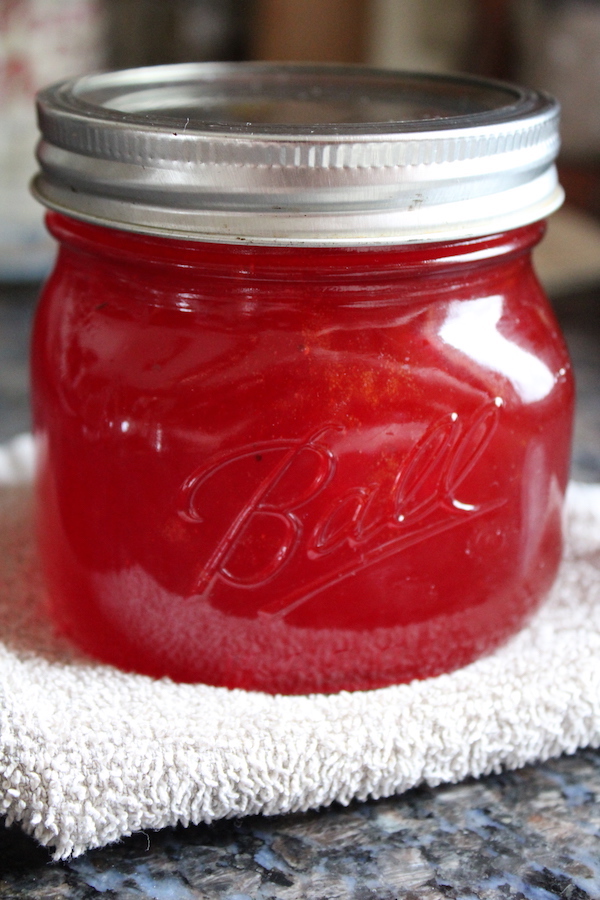
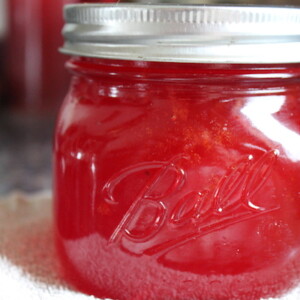
Prickly Pear Jelly
Ingredients
- 4 cups prickly pear juice, from about 8-10 fruits
- 2 cups lemon juice
- 4 cups sugar
- 2 tsp Pomona's Pectin Powder
- 2 tsp calcium water, included with pectin powder
Instructions
- Peel and chop prickly pear fruits. Add them to a saucepan with enough water to cover. Simmer for about 1 hour, adding more water to keep them covered.
- Pour the fruit through a fine mesh strainer and measure the resulting juice. You should have about 4 cups of juice from 8-10 fruits.
- For every cup of juice, add 1/2 cup lemon juice and 1 cup sugar. Reserve a small amount of sugar about 1/4 to 1/2 cup for mixing with the pectin powder.
- Add calcium water and bring the sugar/juice mixture to a boil. Simmer for about 5 minutes.
- Mix the pectin powder with the remaining sugar. This is important because added on its own the pectin will clump instantly on contact with a liquid. Stir in the pectin/sugar mixture and simmer for another 2 minutes.
- Pour the prickly pear jelly into prepared canning jars, leaving 1/4 inch headspace.
- Store jars in the refrigerator, or process in a water bath canner for 10 minutes.
Nutrition
Nutrition information is automatically calculated, so should only be used as an approximation.
More Easy Jelly Recipes
Looking for more canning recipes to keep your jelly jars full?
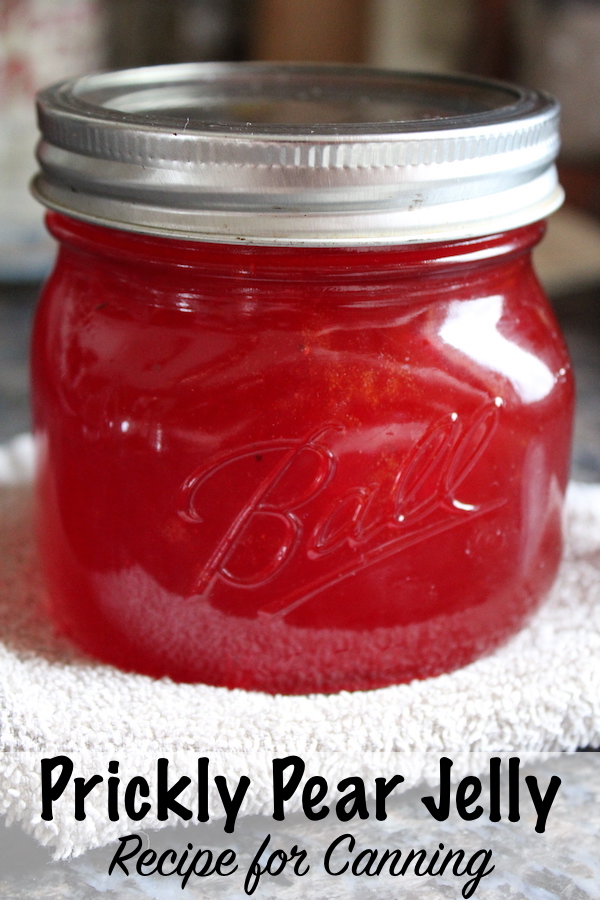
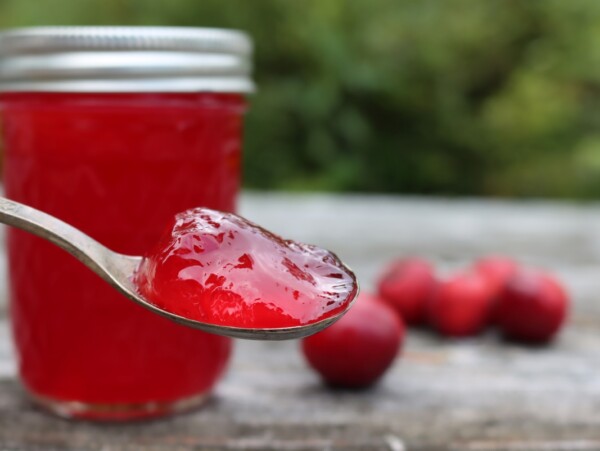
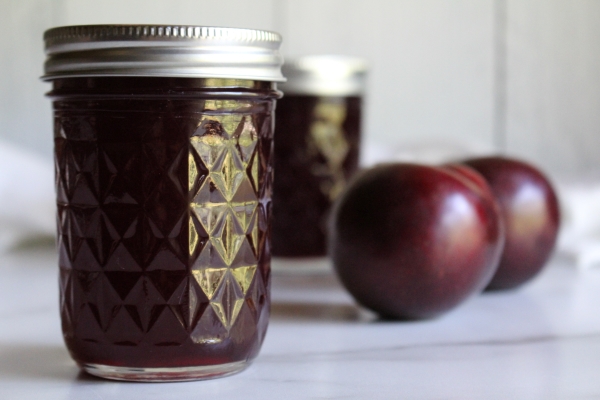
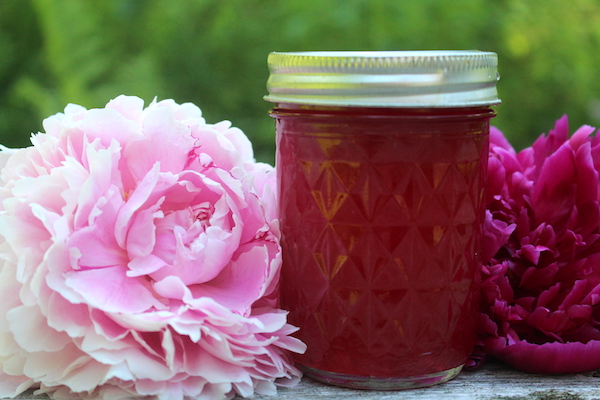
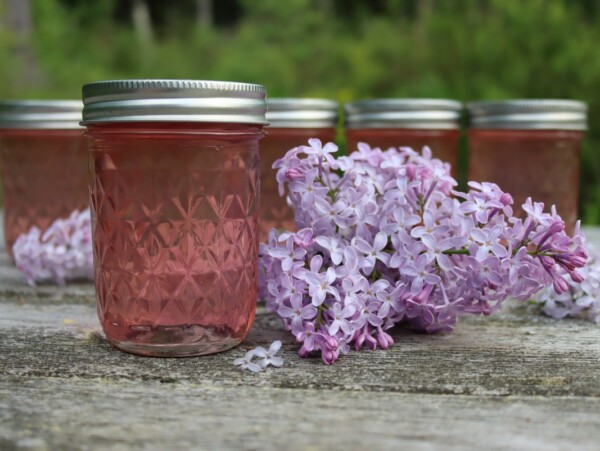










According to the directions on the Pomonas Universal Pectin, they recommend that you use 1/2 cup lemon juice for every 4 cups of fruit. I think this an acceptable amount for the preservation of the jelly without it tasting too much like lemon.
Can you confirm the pectin/calcium amounts? There is only
1 tsp total of calcium in the box and much more pectin. Does the recipe really require 2 tea spoons total of calcium and 2 tea spoons total of pectin?
The recipe calls for 2 tsp of calcium water. To prepare the water, you just need to follow the instructions that come with the pectin. The Pomona’s Pectin calls for 1/2 tsp of calcium powder with 1/2 cup of water. Once you have prepared that water, you will measure out 2 tsp of that solution for the jelly recipe.
I would like to subscribe to your newsletter
That’s great Sarah! Just go to the website at http://www.practicalselfreliance.com and on the right hand side of the page, you will see a box that says “Subscribe Here!”. Just enter your email address in the field below that and click the button that says “Subscribe”.
I have been cooking baking and canning for 40yrs. The ingredient amount for the pectin is incorrect.
I tried this several times and followed the recipe exactly. I waited for about a week, but it never formed. Is there anything I should try different? I really want to try it again. Thank you!
Here is an article that you might try that shows how to fix a runny jam. https://foodinjars.com/blog/canning-101-how-to-save-runny-jam/
Skip the slicing and dicing and peeling.. rinse your fruits in a water bath with a little bit of vinegar and soak for about 30 minutes. Drain, rinse and cover with enough water to boil. Don’t mash fruit. Boil until the pears become pale pink. Strain through a flower sack or triple thickness cheesecloth.
What is the target (recommended) pH for the recipe? The acidity level is mentioned several times without stating the intended target.
Low acid foods have a pH value that is higher than 4.6 and high acid foods have a pH of 4.6 or lower. In order to safely water bath can, foods must be acidic. It’s not necessary to know the specific pH level. You simply need to know which foods are low acid and which are acidic. Low acid foods either need to be pressure canned or acidified by adding lemon juice, vinegar or citric acid.
I am allergic to citric acid. Can I use ascorbic acid insttead?
Ascorbic acid is often used as a pre-treatment to prevent browning of certain fruits and vegetables but from what I have read, you cannot rely on ascorbic acid to increase the acidity in your canning recipe.
Is it safe to can the juice (with the lemon added) to make jelly with later?
Good question, and I assume so? I’ve never tried that and there’s not a “tested” recipe for it, so obviously use your best judgment… but I honestly don’t see why not.
Has anyone ever used the peels for something? Jam, alcoholic beverage, dried?
It seems such a waste to throw it away.
That’s a really good question. I am not aware of any uses for the peels but I also haven’t researched it thoroughly. If you find some good information on it please come back and share.
I have steeped the peels in boiling water overnight, and made a kind of juice out of it! Unfortunately added too much lemon juice, but I think the flavor would be good otherwise. Next time I will freeze the juice as is instead of trying to up to acidity to can it.
Sounds great. Thanks for updating us.
You’re welcome
They compost well if that’s available for you.
Hi Ashley, I have 3 cups prickly pear juice. Can I use white grape juice to make up the difference?…and would the grape juice up the pH enough to make it safe?
I don’t see why you couldn’t add some grape juice into the recipe but I would still add the lemon juice to be sure that it is safe to can or you could leave it out if you want to refrigerate it.
Hello; I would like to make some prickly pear jelly (gelée) to be in a frozen dessert. How much citric acid/lemon juice should I add? What about Pectin and gélatine sheets? Are there any changes to the recipe I should follow so the structure will stand up when defrosted?
I did a quick internet search for frozen dessert recipes that include jelly. It looks like there are quite a few recipes out there that do in fact use jelly or jam. I would just use the recipe as is and try it out.
Followed this recipe. In my humble opinion there is way too much lemon juice added. The taste of the prickly pear is completely lost with the bitterness of the lemon juice. I’ve canned other recipes where the entire batch just requires 3 TBSP or a max of 1/4 cup for the entire batch. How did you come by your calculations?
This amount of lemon juice is required to bring the pH to a safe level for canning. You can try using citric acid instead of lemon juice or you can reduce the lemon juice as much as you want as long as you are going to refrigerate it rather than canning it.
I had 4 cups of juice and added two cups of lemon juice… yuck! Never did thicken it set as a jelly… tried to “fix it” but to me, it was way too much lemon juice. Threw whole batch out as it was not edible as a syrup. Wonder what went wrong.
I’m so sorry that happened. I am not sure what would have caused that to happen. Did you change the recipe in any way or did you follow it exactly as it is written?
Just wondering why the fruit needs to be peeled. If you’re cooking and straining it wouldn’t the tiny stickers be softened and strained out?
You know, that’s a darn good question. I’ve just always seen it peeled before use, but that does seem unnecessary for a jelly. Next time I make it I’ll try it without peeling.
You can just steam the fruit snd then you just strain all the trash and needles out. I am reading that you can even blend the trash and use it in some syrups because the nutrients are pretty great. I sont know for sure. I just have seen some people even use the seeds in other things.
I boil my fruit, without peeling, in a water bath. I strainer everything off, 5 times through strainers and cheesecloth. I add the juice to lemonade. I am making this jelly recipe as we speak with the juice
I made it and did not peel it and there were NO pricklies. I suggest this since it takes up so much time to peel it.
Thank you for the suggestion. It makes perfect sense.
Hi, I have a question. I use a sugar substitute that has a one to one ratio for recipes. Can something like this be used suscessfully in this recipe? Thank you for your time and attention.
Artificial sweeteners should not be used in place of sugar in jelly recipes because the sugar is needed for gel formation.